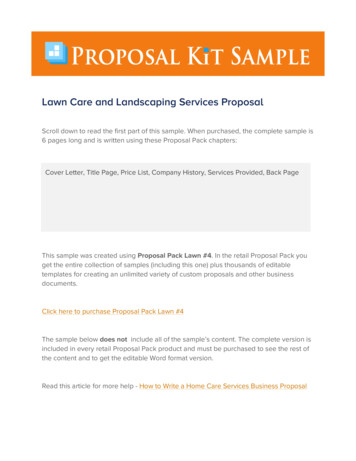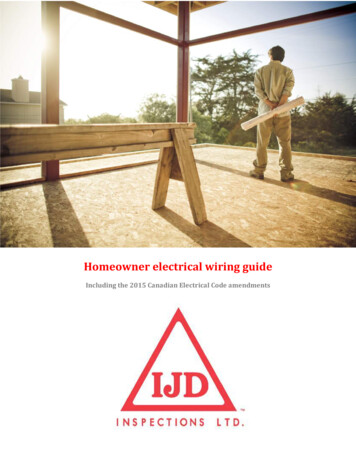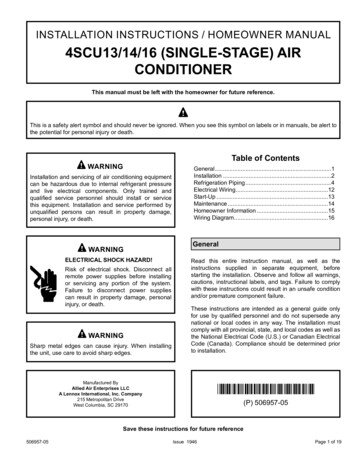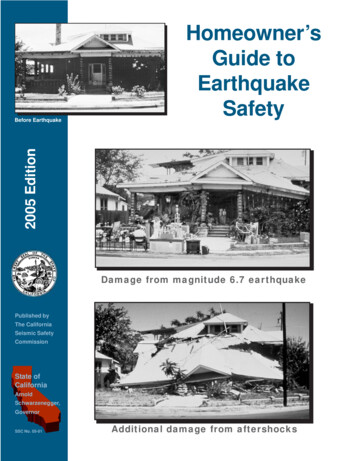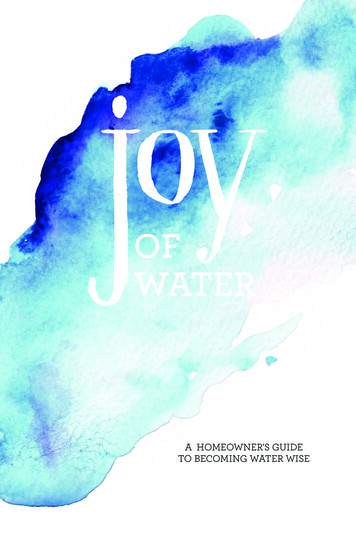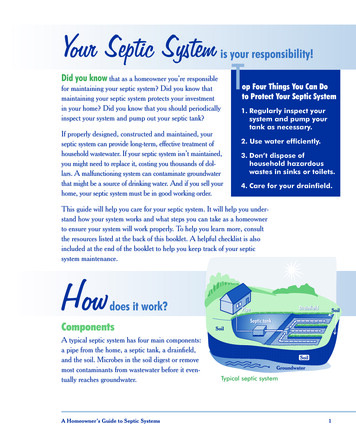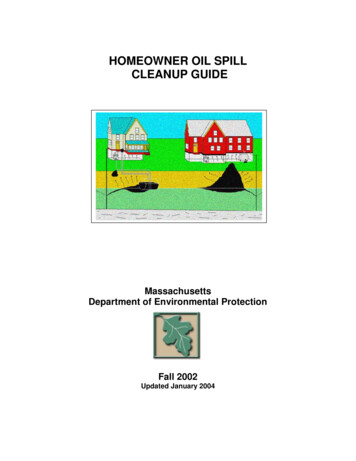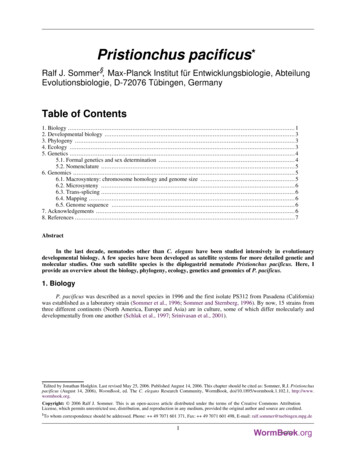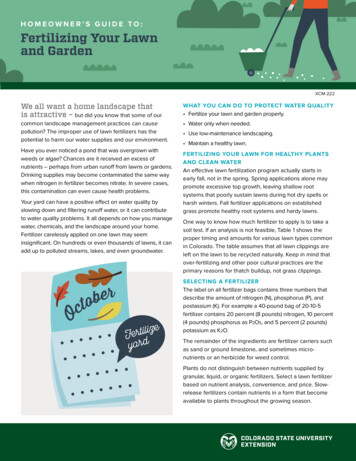
Transcription
HOMEOWNER’S GUIDE TO:Fertilizing Your Lawnand GardenXCM-222We all want a home landscape thatis attractive – but did you know that some of ourWHAT YOU CAN DO TO PROTECT WATER QUALITY Fertilize your lawn and garden properly.common landscape management practices can causepollution? The improper use of lawn fertilizers has thepotential to harm our water supplies and our environment. Water only when needed.Have you ever noticed a pond that was overgrown withweeds or algae? Chances are it received an excess ofnutrients – perhaps from urban runoff from lawns or gardens.Drinking supplies may become contaminated the same waywhen nitrogen in fertilizer becomes nitrate. In severe cases,this contamination can even cause health problems.Your yard can have a positive effect on water quality byslowing down and filtering runoff water, or it can contributeto water quality problems. It all depends on how you managewater, chemicals, and the landscape around your home.Fertilizer carelessly applied on one lawn may seeminsignificant. On hundreds or even thousands of lawns, it canadd up to polluted streams, lakes, and even groundwater.erbotcOizeFertilyard Use low-maintenance landscaping. Maintain a healthy lawn.FERTILIZING YOUR LAWN FOR HEALTHY PLANTSAND CLEAN WATERAn effective lawn fertilization program actually starts inearly fall, not in the spring. Spring applications alone maypromote excessive top growth, leaving shallow rootsystems that poorly sustain lawns during hot dry spells orharsh winters. Fall fertilizer applications on establishedgrass promote healthy root systems and hardy lawns.One way to know how much fertilizer to apply is to take asoil test. If an analysis is not feasible, Table 1 shows theproper timing and amounts for various lawn types commonin Colorado. The table assumes that all lawn clippings areleft on the lawn to be recycled naturally. Keep in mind thatover-fertilizing and other poor cultural practices are theprimary reasons for thatch buildup, not grass clippings.SELECTING A FERTILIZERThe label on all fertilizer bags contains three numbers thatdescribe the amount of nitrogen (N), phosphorus (P), andpostassium (K). For example a 40-pound bag of 20-10-5fertilizer contains 20 percent (8 pounds) nitrogen, 10 percent(4 pounds) phosphorus as P2O5, and 5 percent (2 pounds)potassium as K2O.The remainder of the ingredients are fertilizer carriers suchas sand or ground limestone, and sometimes micronutrients or an herbicide for weed control.Plants do not distinguish between nutrients supplied bygranular, liquid, or organic fertilizers. Select a lawn fertilizerbased on nutrient analysis, convenience, and price. Slowrelease fertilizers contain nutrients in a form that becomeavailable to plants throughout the growing season.
This is advantageous because fewer applications arerequired and leaching losses are less likely. Avoid fertilizersthat contain post-emergence herbicides for broadleaf weedcontrol. Instead, spot spray or pull weeds in trouble spots.APPLYING LAWN FERTILIZERMost garden stores have spreaders that are calibrated fortheir products. The directions on the fertilizer bag usually tellwhere to set the applicator as well.Most established Colorado lawns have adequatephosphorus (P) and potassium (K) in the soil withoutapplying additional fertilizer. Applying a typical blendedN-P-K fertilizer product based on your lawn’s nitrogen (N)needs will usually result in application of more P and K thanmost Colorado lawns require.If you are not sure where to set the spreader, put it on a“low” setting to avoid over-fertilizing. Go back over the lawnat a right angle to the first application if you did not getenough on the first pass. This will insure a more uniformapplication. Always sweep up fertilizer that landed onsidewalks and driveways onto the lawn afterwards.DETERMINING HOW MUCH TO BUYDetermine how much fertilizer you need before you make apurchase to avoid storing leftover materials. Measure the areaof your lawn to get an idea how many square feet you have tofertilize. Read the fertilizer bag to determine how muchnitrogen is in the bag. For example, if you want one pound ofN per 1,000 square feet from a 46-0-0 product, you need toapply nine pounds of fertilizer on a 4,000 square foot lawn(see Table 1.) Fertilizer applied above the recommended rate iswasted money and potentially harmful to water resources andaquatic life. Excess fertilizer also overstimulates lawn topgrowth, requiring more frequent mowing.COMMERCIAL TREE AND LAWN CARE COMPANIESIf all of this sounds too complicated, you may want to considerusing the service of a professional company to maintain yourlandscape. A reputable service offers licensed applicatorswho are trained to handle and apply chemicals properly.Table 1. Pounds of fertilizer required for various lawn sizes usinga one pound N/ 1,000 sq. ft. application rate.% NITROGEN (N) ON LABELSQUARE5101520253446FEET OFLAWNFERTILIZER REQUIRED FOR 1 LB. N/1,000 SQ. FT. 080402620161286000120603930241812NITROGEN (N)POTASH (K20)20-5-10TOTAL N.20%AVAILABLE P205.5%AVAILABLE K20.10% Do you really need the “perfect lawn” provided in a“full-service” lawn care package? A low-maintenanceprogram might be more suitable. Are routine insecticide applications desirable? The vastmajority of the insects found in Colorado lawns are neutralor beneficial – lawn insecticides are only occasionallyneeded under our conditions. Are routine herbicide applications needed? Weeds are notthe cause of an unhealthy lawn – they are the result. Inmany cases, an attractive lawn can be maintained withsound watering, fertilizing, mowing, and aeration. Are all of those fertilizer nutrients necessary? Mostcommercial fertilizers contain phosphorus (a potential waterpollutant) even though in many cases it is alreadyadequately supplied in your soil. Consider a soil test beforeapplying fertilizer nutrients besides nitrogen.In short, a “one-size-fits-all” lawn program may not be bestfor you or the environment. Question the blanket use ofchemicals in favor of a more tailored program.FERTILIZING LANDSCAPE AND GARDEN PLANTSNutrient requirements for garden plants can varyconsiderably. In general, nitrogen promotes leafy top growth.Phosphorus is needed for good root development.Potassium is necessary for winter hardiness, diseaseresistance, and general plant health.POUNDSPHOSPHATE (P205)Some areas of consumer caution should be noted.RATIOANALYSISAlways improve the soil prior to planting by incorporating agood organic soil amendment such as aged manure orcompost to develop a rich, well-drained soil. If plants showyellowing leaves, consult your county Extension office orMaster Gardener for nutrient recommendations. Irondeficiency may cause yellow landscape plants in Colorado.Most established trees and shrubs planted in well- drained,fertile soils do not need annual fertilizer applications.
Table 2. Recommended nitrogen fertilizer schedule where clippings are not collected.FERTILIZER APPLICATION SCHEDULE FOR ESTABLISHED COLORADO LAWNSGRASS TYPEMID-MARCHTO APRIL1MAY TOMID-JUNEJULY TOEARLY AUG.MID-AUGUST TOMID-SEPTEMBEREARLY OCT. TO EARLY NOVEMBER(WHEN GRASS IS STILL GREEN)2(pounds of nitrogen per 1000 square feet of lawn)LOW-MAINTENANCE 1/21/2BLUE GRASS/RYEGRASS3NOTREQUIRED11 (OPTIONAL)TURF-TYPE1/21/2-1TALL FESCUENOTREQUIRED11 (OPTIONAL)FINE FESCUE1/21/2-1NOTREQUIRED1/2-1NOT REQUIREDBUFFALOGRASS/BLUE GRAMA/BERMUDAGRASSAPPLY NO NAPPLY NO NAPPLYNO N1/2-11/2-11TheMarch-April nitrogen application may not be necessary if you fertilized late the previous fall (Sept. to Nov.). If spring green-up and growth issatisfactory, delay fertilizing until May or June.2On sandy soils, do not fertilize after late September. Winter precipitation can cause nitrogen to leach into groundwater. Slow-release fertilizers,such as sulfur-coated, and natural, organic-based fertilizers are recommended on sandy soils to prevent leaching losses.3Highmaintenance bluegrass lawns with heavy use may benefit from an additional ½ pound for each spring application.Adapted from Colorado State University Extension Fact Sheet 7.202, Lawn Care.However, if plants are growing poorly and you cannot identifya specific pest or weather-related reason, a nutrientdeficiency may be the problem.The easiest and most economical method of fertilizing is tosprinkle a balanced liquid or granular fertilizer material underthe plant and water it in. Mulching will help conserve moisture,protect roots, and prevent the loss of soil and nutrients.Vegetable gardens are a great place to incorporatecomposted waste materials from your kitchen and garden.Aged or composted animal manures are also a good way toimprove garden soils.Some vegetables, such as corn or tomatoes, may benefitfrom the addition of a low analysis, complete mineral fertilizer(such as 5-10-5) added at the rate of approximately 10 to 20pounds of material per 1,000 square feet of garden. Cornrequires more N than tomatoes. Fruit production can bedelayed if too much N is applied to tomatoes. (See FactSheet 7.611, Fertilizing the Vegetable Garden.)MAINTAINING A HEALTHY LAWNWhen grass is dense and vigorous, it competes effectivelyagainst most pests. A sound watering and fertilizationprogram is basic for a healthy lawn.Other things you can do include: When installing new or replacement sod, prepare your soilwell with deep tillage and compost amendments. Maintain a mowing height at 2½ to 3 inches. Thisencourages deeper rooting and heat resistance.Excess fertilizer nutrients from lawn and gardenrunoff can cause overgrowth of aquatic weedsand algae, degrading fish and wildlife habitat andrecreational opportunities.
A yard under xeriscape can be maintained with less water and fertilizer in many situations. Mow often enough so that you can mulch grass clippingson the lawn to recycle the nutrients. Leaving grass clippingsdoes not cause thatch. Core aerate your lawn at least once a year to encouragegood rooting and water penetration. Keep your mower blade sharpened to avoid ragged cuttingthat increases moisture loss and stress.WATERING YOUR YARDPoor watering practices are probably responsible for morelandscape problems in Colorado than any other single factor,except maybe our weather. Over- watering causes the lossof nutrients to the environment and is not particularly goodfor most landscape plants. However, making precisewatering recommendations is difficult due to a combinationof factors that includes different plant moisture needs,different soil types, and varying weather conditions.LOW-MAINTENANCE LANDSCAPESYou can make a positive impact by designing your landscapewith plants that require less water and fertilizer, and havefewer pest problems.Alternatives to Kentucky blue grass, such as buffalograss,blue grama grass, and turf-type fescue can provide abeautiful lawn that requires fewer resources. However, beaware that each alternative grass has its own advantages,disadvantages, and maintenance needs. Often, homeownersplant grass in areas that are too shady, or that have steepslopes or poor soils where lawn grass just doesn’t grow well.More fertilizer and water are not the answers in these cases.It’s usually best to replace this grass with hardy groundcovers, ornamental bunch grasses, or mulch. Xeriscape orlow-maintenance landscape plants are less dependent onfertilizer and water inputs.In general, a sandy soil should receive ½ to 1 inch of waterper application, while a clay soil should receive less frequentand gradual applications of 1 to 1 ½ inches of water. A densestand of Kentucky blue grass may need up to 2 inches ofwater per week during the hottest part of the summer, butother grasses such as tall fescue may thrive on less if theyhave well- developed roots.Additionally, they help attract songbirds, butterflies, andbeneficial insects. Check with your local nursery forrecommendations specific to your area. Also, visit extension.colostate.edu to find the following fact sheets: CreativeLandscaping (7.228), Xeriscaping: Ground Cover Plants(7.230), Sustainable Landscaping (7.243), and WateringEstablished Lawns (7.199).Over-watering is wasteful and can transport contaminants viarunoff from the soil surface or percolation below the rootzone. Homeowners with automatic sprinkler systems need topay attention to weather patterns and their landscape’swater needs. Turn off or reset sprinklers after rain or duringperiods of cool weather (See Fact sheet 7.239, Operatingand Maintaining a Home Irrigation System).Finally, landscapes designed to hold rain and snow melt areenvironmentally friendly because they result in less waterrunoff. Keeping any part of your property that borderssurface water in a dense natural vegetation can help filterout chemicals that might be carried in runoff water.
SMALL CHANG E SSIMPLE THINGS YOU CAN DOTO PROTECT WATER QUALITY Redirect downspouts tovegetated areas. Select landscape plants that arewell adapted to your site andhave low water requirements. Mow your grass high and oftenso that clippings and theirnutrients can be recycled. Water your lawn on an “asneeded” basis, rather than on apre-set schedule. Adjust sprinklers to avoidwatering paved areas. Treat specific weedy areas ratherthan resorting to general “weedand feed” mixtures. Use only the amount of fertilizeror compost that is recommended.More is NOT better. Keep fertilizers and pesticidesoff sidewalks and driveways. Wash off fertilizer applicationequipment on the lawn, not onthe sidewalk or driveway. Maintain natural buffer areaswhere no chemicals are appliedbetween your property and anystream, lake, or drainage way.A well-managed landscape canbe part of the solution insteadof contributing to waterquality problems.ADD U P
More information on protecting water quality can be foundin the other Homeowner’s Guides at extension.colostate.edu.XCM-119, Household Water ConservationXCM-220, Pesticide Use Around the Home and GardenXCM-221, Alternative Pest Management for the Lawn and GardenXCM-223, Protecting Water Quality and the EnvironmentFertilizing Your Lawn and Garden - This publication was written byR. Waskom, T. Bauder, and E. Wardle Colorado State University Extension. 2018
Adapted from Colorado State University Extension Fact Sheet 7.202, Lawn Care. (pounds of nitrogen per 1000 square feet of lawn) Table 2. Recommended nitrogen fertilizer schedule where clippings are not collected. . landscape problems in Colorado than any other single factor, except maybe our weather. Over- watering causes the loss
